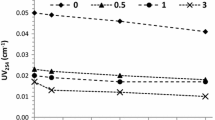Abstract
Many drinking water utilities that use source waters with significant bromide ion levels are currently seeking disinfection regimes that will minimize the formation of brominated disinfection byproducts while providing adequate disinfection. While ozonation appears to be a promising option for achieving these goals, the uncertainty of future drinking water regulations has developed a need for predicting actual disinfection byproduct formation prior to the costly investment for upgrading existing treatment facilities. The models developed in this paper provide comparisons of ozonation application methods, providing a basis for minimizing bromate and aiding in future design considerations. Theoretical and empirical models for the determination of ozone transferred, dissolved ozone concentrations, and bromate formation have been derived and compared with pilot-scale and full-scale data; a good agreement has been observed between the actual data and the predicted data, showing the validity of these models. True-batch bromate formation more closely simulated pilot-scale and full-scale data. Bromate formation in one stage vs two stage ozone contactors and different reactor configurations have been compared. Ozone gas phase concentration appears to have an effect on bromate formation as well.
Similar content being viewed by others
References
APHA: 1989, Standard Methods for the Examination of Water and Wastewater, APHA-AWWA-WPCF, 17 th Edition.
Bellamy, W. D. et al.: 1992, "Full-Scale Ozone Contactor Evaluation", AWWA Annual Conference, Vancouver.
Gramith, J., Coffey, B., Krasner, S., Kuo, S. and Means, E.: 1993, "Demonstration-Scale Evaluation of BrO -3 Formation and Control Stategies", AWWA Annual Conference Proceedings, San Antonio, Texas.
Hull, C., Singer, C., Saravanan, K. and Miller, C.: 1992, "Ozone Mass Transfer and Reaction: Completely Mixed Systems", AWWA Annual Conference, Vancouver.
Hulsey, B., Jackson, L. and Foellmi, S.: 1993, "Ozone Contact Basin Tracer Testing at the Tucson Water Cap Treatment Plant", IOA Proceedings, San Francisco, CA.
Krasner, S., Glaze, W., Weinberg, H., Daniel, P. and Najm, I.: 1993, "Formation and Control of BrO -3 During Ozonation of Waters Containing Bromide Ions", JAWWA 85, 1.
Kuo, S., Krasner, S., Stalker, G. and Weinberg, H.: 1990, "Analysis of Inroganic Disinfection Byproducts in Ozonation Drinking Water By Ion Chromatography", AWWA Annual Conference Proceedings, San Diego, CA.
Levenspiel, O.: 1972, Chemical Reaction Engineering, Second Edition, Wiley International Edition.
Marinas, B., Liang, S. and Aieta, E.: 1992, "Performance of Ozone Bubble-Diffuser Contactors: A Plit-Scale Study", AWWA Annual Conference Proceedings.
Rakness, K. Johnson, G.: 1993, "Ozone Contactor and Generation System Design Models", 11th IOA Proceedings, San Francisco, CA.
Roth, J. and Sullivan, D.: 1983, "Kinetics of Ozone Decomposition in Water", Ozone: Science and Engineering5(1), 37-49.
Roche, P., Volk, C. and Pillard, H.: 1984, "Water Oxidation by Ozone or hydrogen Peroxide Using the Ozotest or Peroxotest Methods", Ozone: Science and Engineering 16, 135-155.
Rouston, M., Beck, C., Wable, O., Duguet, J. and Mallevialle, J.: 1993, "Modeling Hydraulics of Ozone Contactors", Ozone: Science and Engineering 15, 213-226.
Siddiqui, M., Amy, G., Miller, K., Ozekin, K. and Westerhoff, P.: 1993, "The Role of Tracer Studies in Relating Laboratory and Full-Scale data", 11th IOA Conference Proceedings, San Francisco.
Siddequi, M., Amy, G., Ozekin, K., Westerhoff, P.: 1994, "Theoretical and Empirical Models for Predicting Ozone DBPs", Ozone: Science and Engineering 16: 2.
Schwartz, B., Fung, L. and Wenf, C.: 1990,, "Determination of Ozone Concentration in Turbine Contactor", EPA Workshop on Ozone CT, Cincinatti, OH.
Stolarik, G. and Christie, J.: 1987, "Projection of Ozone CT Values, LA Aqueduct Filtration Plant", International Ozone Association Conference, Monroe, MI.
USEPA.: 1990, "Guidance Manual for Compliance with the Filtration and Disinfection Requirements for Public Water Systems Using Surface Water Sources", Prepared by Malcolm Pirniw, Inc., and HDR Engineering, Inc., for the USEPA Office of Drinking Water, Washington, D. C.
Wehner, J. F. and Wilhelm, R. F.: 1958, "Boundary Conditions of Flow Reactor", Cheng Eng. Sci. 6, 89.
Westerterp, K. R. and van Swaaij, W. P. M.: 1973, Chemical Reactor Design and Operation, John Wiley and Sons.
Author information
Authors and Affiliations
Rights and permissions
About this article
Cite this article
Siddiqui, M., Amy, G., Ozekin, K. et al. Modeling Dissolved Ozone and Bromate Ion Formation in Ozone Contactors. Water, Air, & Soil Pollution 108, 1–32 (1998). https://doi.org/10.1023/A:1005025115868
Issue Date:
DOI: https://doi.org/10.1023/A:1005025115868




